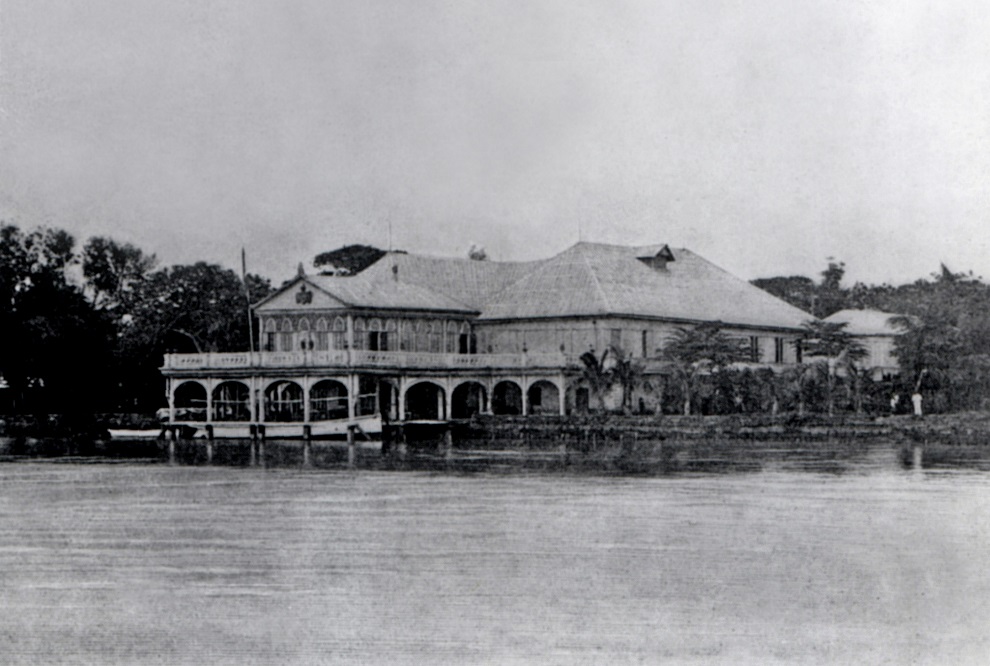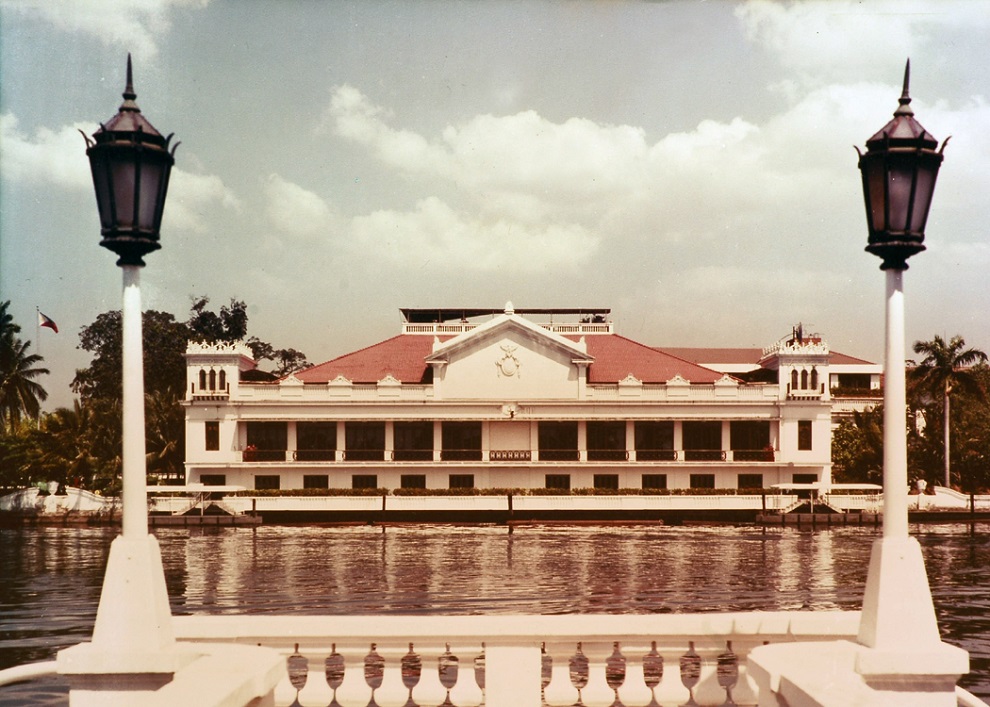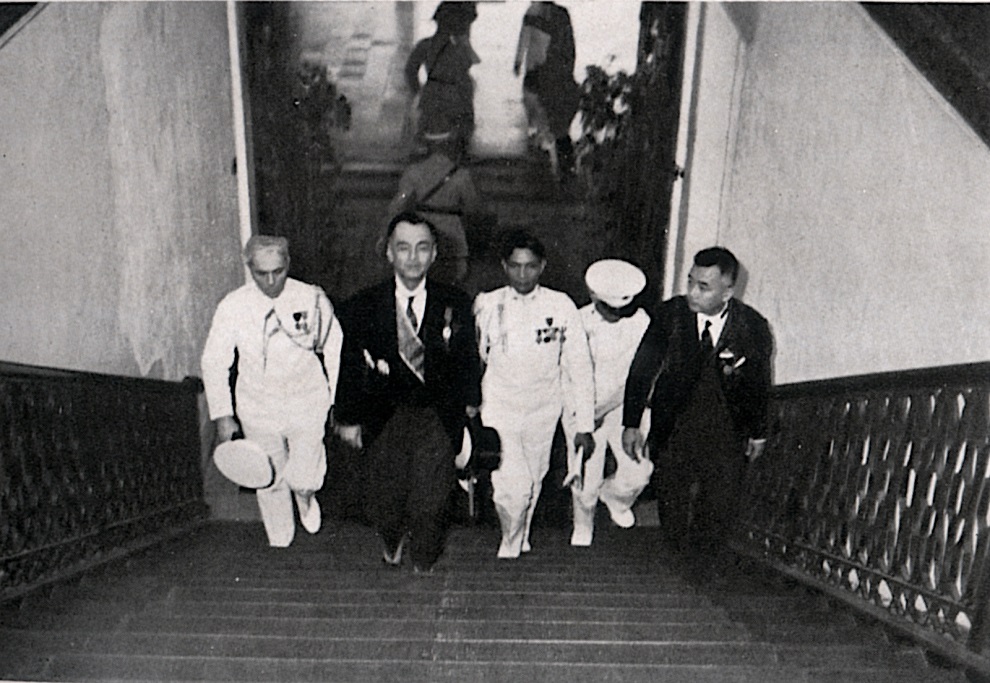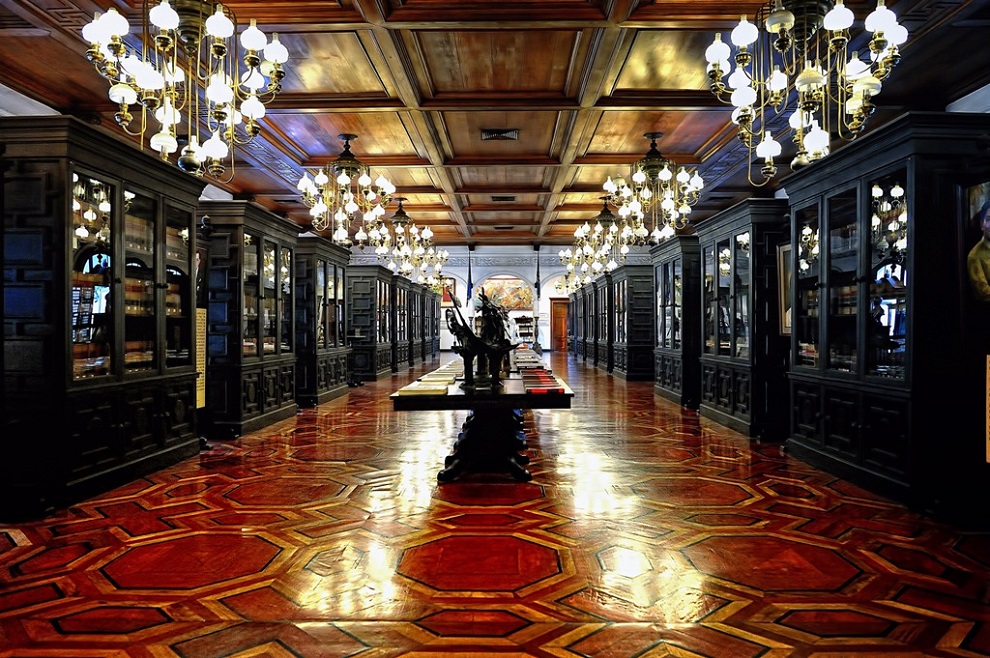Malacañang Palace
The official residence of the President of the Philippines is Malacañan Palace. Situated in the old Manila district of San Miguel, over the 175 odd years that government has owned the place, the buildings have been remodeled, expanded, demolished and rebuilt, and adjoining lands bought. Most recently, in 1978 to 1979 the Palace itself was drastically remodeled and extensively rebuilt by then First Lady Imelda Romualdez Marcos.
The first recorded owner of the property is Luis Rocha, a Spaniard in the Galleon trade. The Rocha property was built of stone, described as being a relatively modest country house (although modern day Rochas say it was not small and in fact had a ballroom) with a bath house on the river and gardens, all enclosed by a stone fence. The latter was probably a nipa-roofed and bamboo-enclosed structure built on the water, where away from the gaze of passing boats, the Rochas and their guests could enjoy the rushing water while clinging to a rope – a favorite pastime of the era. It was one among many weekend homes of the elite, located in San Miguel, Paco, and Sta. Ana along the Pasig river and its tributaries, easily accessible from Intramuros and Binondo by boat or carriage or on horseback. The still standing “Carriedo House” within the Sta. Mesa campus of the Polytechnic University of the Philippines, may have been one of these weekend homes.
Luis Rocha sold the property in 1802 to Colonel Jose Miguel Fomento of the Spanish Army. Fomento’s testamentary executors in turn sold it to the government upon his death in 1825.
The Spanish Governors General had lived grandly in Intramuros since the 17th century in the Palacio del Gobernador on the Plaza Mayor (now Plaza Roma). The “Posesion de Malacañang” as it was called, was a country home and temporary residence of outgoing Governors General awaiting the next ship to Spain.
The great earthquake of June 3, 1863 felled the Palacio in Intramuros. The Governor General had to move to Malacañan Palace. Finding the place too small, a wooden two-storey building was added at the back of the original structure, as well as smaller buildings for aides, guards and porters, as well as stables, carriage sheds and a boat landing for river borne visitors.
The newly closed Colegio de Sta. Potenciana was remodelled into the Palacio Provisional de Sta. Potenciana, located at the site where now stands the Philippine National Red Cross and possibly the National Commission for Culture and the Arts Buildings on General Luna Street. With Sta. Potenciana ready, the Governor General moved back to Intramuros in 1865. Meanwhile, repairs continued at Malacañan Palace. Work must have been just completed when another earthquake struck, badly damaging both Sta. Potenciana and Malacañan Palace. The Governor General moved to an office building on Calle Cabildo in Intramuros.
Malacañan Palace was once again repaired and improved. Its posts were strengthened, roof tiles replaced with corrugated iron sheets, balconies repaired and both exterior and interior beautified. As luck would have it, no sooner were these completed when fresh calamities struck: a typhoon in October 1872, an earthquake in December 1872, a fire in February 1873, another fire in 1873 after repairs were completed, and a bad storm in May 1873. After that, rebuilding resumed in earnest, with new wings, azoteas, rooms, and galleries, over the next four years (1875-79).
By the time the Americans took over in 1898, Malacañan Palace was a rambling Spanish colonial period complex of buildings, built of wood, with sliding capiz windows, patios and azoteas.

The American Governors General abandoned the plan to reconstruct the old Palacio at Intramuros. Instead, they continued to improve and enlarge Malacañan Palace, buying up more land, reclaiming more of the Pasig River, raising the ground level (to keep above flood waters), changing wood to concrete, and beautifying the interiors with hardwood panelling and magnificent chandeliers.
In 1920, the Executive Building was constructed by Governor General Francis Burton Harrison. Till then, the Governor General had to commute daily to his office at the Ayuntamiento Building. Gov. Gen. Leonard Wood was the last chief executive to hold office in Intramuros and the first in Malacañan Palace. Gov. Gen. Dwight Davis (1929-32) notably extensively rebuilt the Palace itself.

Beginning 1935, when Manuel L. Quezon moved to Malacañan Palace as the President of the Commonwealth, Palace improvements were continued, including the construction of the Social Hall (now Heroes Hall on the ground floor, intended for dining and dancing and non-official social affairs), State Dinning Room and the famous Pasig River facade. It was then First Lady Doña Aurora who saw to the construction of a Palace chapel, which is at the left of the main entrance, on time for the 33rd International Eucharistic Congress in 1937.
Malacañan Palace survived the Second World War, the only survivor among the major government buildings of Manila. The southwest side of the Palace, which would have been the State Dining Room and its service area, was damaged by shelling, but the rest was unscathed. Malacañan continued to be the jewel of the still fashionable district of San Miguel, spared by the war, unlike Ermita, Malate and Paco across the river which were devastated.

The Marcos family bid Malacañan Palace goodbye in the evening of February 25, 1986, a few hours after President Marcos took his oath for a six-year term before Chief Justice Ramon Aquino. Fulfilling a campaign promise, President Corazon C. Aquino decided to live in what had been the Arlegui Guest House and held office in the Premier Guest House. Her successor, President Fidel V. Ramos, also decided to live in the Arlegui Guest House but held office in the Palace. President Joseph Ejercito Estrada remodelled the Premier Guest House into a combination residence and office. In January 2001, President Gloria Macapagal-Arroyo returned to the Palace and made it both her residence and office. President Benigno S. Aquino III, in 2010, chose not to reside in the Palace but in Bahay Pangarap, located within Malacañang Park, and holds office in Bonifacio Hall of Malacañan Palace.



































